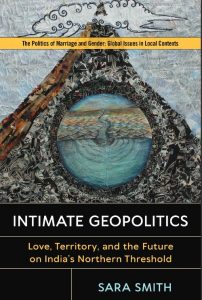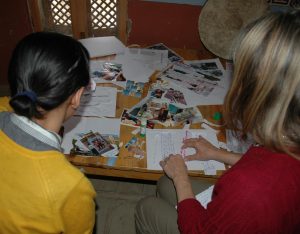I am a feminist political geographer interested in the relationship between territory, bodies, and the everyday. In my research, I  seek to understand how politics and geopolitics are constituted or disrupted through intimate acts of love, friendship, and birth. I have worked on these questions in the Ladakh region of India’s Jammu and Kashmir State in relation to marriage and family planning. My first book, Intimate Geopolitics: Love, Territory, and the Future on India’s Northern Threshold, was published by Rutgers University Press in March 2020. My second book, Political Geography: A Critical Introduction was published by Wiley in April 2020. You can find all my publications on my CV.
seek to understand how politics and geopolitics are constituted or disrupted through intimate acts of love, friendship, and birth. I have worked on these questions in the Ladakh region of India’s Jammu and Kashmir State in relation to marriage and family planning. My first book, Intimate Geopolitics: Love, Territory, and the Future on India’s Northern Threshold, was published by Rutgers University Press in March 2020. My second book, Political Geography: A Critical Introduction was published by Wiley in April 2020. You can find all my publications on my CV.
 I am now engaged in a project on marginalized Himalayan youth , with Dr. Mabel Gergan. The latest publication from this collaborative work is just out in cultural geographies , titled, “Politics, pleasure, and difference in the intimate city: Himalayan students remake the future.” We are excited to also be working on making a zine together with Rinchen Dolma at the Ladakh Arts and Media Organisation, and a group of students. You see some of their work in the header above.
I am now engaged in a project on marginalized Himalayan youth , with Dr. Mabel Gergan. The latest publication from this collaborative work is just out in cultural geographies , titled, “Politics, pleasure, and difference in the intimate city: Himalayan students remake the future.” We are excited to also be working on making a zine together with Rinchen Dolma at the Ladakh Arts and Media Organisation, and a group of students. You see some of their work in the header above.
I also pursue issues of intimate geopolitics as they emerge in the national (U.S.) and global context, through collaborations with Banu Gökariksel, Chris Neubert, Pavithra Vasudevan, Mabel Gergan, Carlos Serrano, and Pallavi Gupta. Most recently, I have coauthored an article in Signs on “Demographic Fever Dreams,” and an editorial on race and US immigration policy.
Pavithra, my former PhD student and I just edited a special issue on “Race, Biopolitics, and the Future,” now open access at Environment and Planning D: Society and Space. We are also working on questions of race and the Anthropocene as envisioned in scenes of apocalyptic film, with my former PhD student, Mabel Gergan, and have published an article on this, “Earth beyond repair.”
Banu and I have published two pieces using feminist theory to analyze our contemporary political moment: one on the fascist body politics of Donald Trump, now made open access by Political Geography, and a second one on “Intersectional feminism beyond the US flag hijab and pussy hats,” in Gender, Place and Culture. Our most recent piece from this collaboration is “Reassessing the Trump presidency one year on,” an invited contribution to Political Geography.
My other most recent publications include a co-authored piece on the political demography of the global “Baby Bust,” with Paul Robbins, and a reflection on methodology, “Intimacy and angst in the field.” Banu Gökariksel, Nathan Swanson, and I also recently published a special issue at Area: “Bodies, territory, and borders.”
I am in collaboration with Pat Parker, Jean Dennison, and Dorothy Holland in thinking through strategies for decolonizing how methodology is taught in the university (two articles coming soon!), and parallel to this I am a founding member of the FLOCK feminist collective, and a member of the organizing team for the 2017 Feminist Geography conference at UNC.
Please email me at shsmith1@email.unc.edu if you would like PDF versions of any of the publications listed below, or visit me at ResearchGate or Academia.edu. You can follow me on twitter @GeogSara.
Intimate Geopolitics
Since 2004, my research has engaged with the politics of marriage and fertility in Ladakh’s Leh District. As residents of Jammu and Kashmir State, Ladakhis have experienced the politicization of religious identity over the course of the twentieth century as the colonial logics linking population and territory unfolded during and after partition. Ladakhis struggle to make their political demands heard in the context of geopolitical conflict and territorial uncertainty. Since the 1980s, increasing tension between Leh’s Buddhist majority and its Shia and Sunni minorities has entangled decisions about marriage and babies in disciplinary political narratives. This research explores the territorial logic manifest in a pro-natal campaign and a ban on religious intermarriage, as well as the ways that people cope with such territorial logic. My research has included survey work and interviews, as well as oral history and photography projects with Ladakhi youth. The research has been funded by Fulbright-Hays, the Social Science Research Council, and the Society of Women Geographers.
To expand this work beyond the South Asian context, I have been developing a special section titled “Bodies, Territory, and Borders” for the journal Area, in collaboration with Banu Gökariksel, Nathan Swanson, and Agnes Chew.
I have published on this work in the Annals of the Association of American Geographers, Political Geography, Gender, Place & Culture, and others. Please see my publications page for details.
Growing up in a geopolitical world
 How do young people form their political subjectivities in relation to geopolitical conflict and local political struggles? I am developing a new research project studying how Himalayan youth understand their place in the world as they navigate the movement between their remote Himalayan homes and the major urban centers they travel to for higher education. Groundwork for this project involved a study with the Students’ Educational and Cultural Movement of Ladakh in 2007, an oral history project with Ladakhi high school students in 2008, and a photography project in 2010 in collaboration with the Ladakh Arts and Media Organization (LAMO). Since 2011, I have been collaborating with LAMO and with my PhD student, Mabel Gergan on a long-term investigation of
How do young people form their political subjectivities in relation to geopolitical conflict and local political struggles? I am developing a new research project studying how Himalayan youth understand their place in the world as they navigate the movement between their remote Himalayan homes and the major urban centers they travel to for higher education. Groundwork for this project involved a study with the Students’ Educational and Cultural Movement of Ladakh in 2007, an oral history project with Ladakhi high school students in 2008, and a photography project in 2010 in collaboration with the Ladakh Arts and Media Organization (LAMO). Since 2011, I have been collaborating with LAMO and with my PhD student, Mabel Gergan on a long-term investigation of  these questions involving interviews, surveys, and participatory photography.
these questions involving interviews, surveys, and participatory photography.
Thus far I have published work from this research both individually and in collaboration with Mabel, in Transactions of the Institute of British Geographers, Environment and Planning D: Society and Space, and elsewhere. Please see publications for details.
Gender Politics of Right-Wing Nationalism and Feminist Interventions
With Banu Gökarıksel (Geography, UNC-CH) we examines the gender politics of right-wing nationalism and feminist interventions in this project. Our analysis builds on feminist geopolitics, critical race theory, and gender studies and includes three distinct but related topics:
1) Fragile virility: The ‘strong man’ as an image, embodied performance, and discourse is central to right wing nationalist politics but his virility is always understood to be under threat and thereby in need of vigilant protection and aggressive action. Although this construction of fragile virility is common to many right wing nationalist movements, it takes a slightly different form in each specific context. For example, Trump evokes and appeals to a threatened white masculinity in the US, Erdogan to an oppressed devout Sunni Muslim majority in Turkey, and Modi and Hindu nationalism threatened by Romeo jihadis in India. (See “Making America great again?”: The fascist body politics of Donald Trump, Intersectional feminism beyond U.S. flag hijab and pussy hats in Trump’s America, and forthcoming article)
2) Demographic fever dreams (with Chris Neubert (Geography, UNC-CH)): Concerns over population change, such as immigration and who is going to have the nation’s babies, play a significant role in right wing nationalism. The threats to the nation, as well as the dreams for the future of the nation often focus on population statistics but despite the vivid specificity of the stories that circulate about demographic threats or fantasies, these stories are rarely based on facts.
3) Feminist interventions: Feminist perspectives and action have been crucial to analyze and to resist right wing nationalism/populism with their attention to gendered, racialized, and classed power structures. However, feminist reactions that rely on “feel good” symbols and modes of resistance (such as pink pussy hats in the Women’s March on Washington or the poster of the US flag hijab) have been limited because they have not questioned nationalism, settler colonialism, and capitalism that underwrite masculine dominance, white supremacy, and everyday forms of gendered violence. Our project takes a feminist perspective to analyze the gender and racial politics of right wing nationalisms but also to critically consider the shortcomings of “comfort feminism”, instead seeking more deeply intersectional feminism. (See Intersectional feminism beyond U.S. flag hijab and pussy hats in Trump’s America)
Related to this work and building on the Feminist Geography Conference we organized at UNC-CH in May 2017, Banu Gökarıksel, Chris Neubert, Mike Hawkins (Geography), and I are editing a book called “Feminist Geography Unbound: Intimacy, Territory, and Embodied Power” for the Gender, Feminism, and Geography book series edited by Jennifer Fluri and Amy Trauger for West Virginia University Press.
With Banu Gökarıksel and Nathan Swanson, we edited a special issue of the journal Area on Territory, Bodies, and Borders.
Critical approaches to methodology
In relation to the work above I have been striving to develop careful and ethical approaches to qualitative research. This has involved a collaborative interdisciplinary pedagogical project with Jean Dennison (University of Washington Anthropology), and an article in Gender, Place & Culture. In 2017, I published two articles related to this work, in collaboration with Jean Dennison, Pat Parker, Dorothy Holland, and Melvin Jackson. You can see these in my publications site.
The Struggle for Hurston Hall: Racial Justice Activism at UNC (funded by the UNC-CH Institute of Arts and Humanities)
This project is conducted by a collective of geography graduate students (Michael Hawkins, Stevie Larson, Chris Neubert, Sara Maxwell, and Pavithra Vasudevan) and faculty (Banu Gökarıksel and Sara Smith) working to raise awareness about social justice at UNC-CH. We are committed to feminist approaches to producing knowledge for social change. Identifying racial justice as a primary concern and inspired by students movements, we seek to use art, performance, and creative mapping to move beyond anemic and apolitical institutional approaches to diversity that center whiteness as the norm and fetishize the diverse campus as a metric or checkbox. As faculty and students, how can we work from our shared space but different subject positions to further a justice-based vision of a different future? What role might art play in understanding and interpreting the past and in enacting change?
We see the current moment – in which questions of race and justice are highlighted on the national stage – as an ideal time to place our campus within this national (and global) dialogue. As geographers, we begin from our physical space on campus – the Hurston Hall building – and seek to document how student-led activism to remove the Saunders name from the building – and the institutional response, (designating the building as “Carolina Hall”) – are revealing of the ways that the university campus functions as a site for new visions of justice and the limited institutional work framed as diversity and inclusivity. We will use interactive visual and performance arts methods to construct an alternate archive documenting and exploring how racial histories are experienced, narrated, and contested in campus struggles for memorialization.